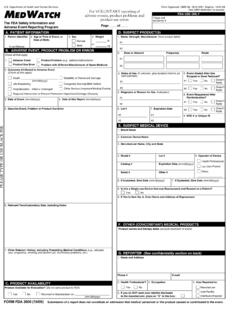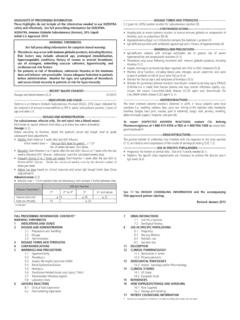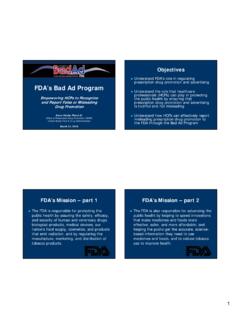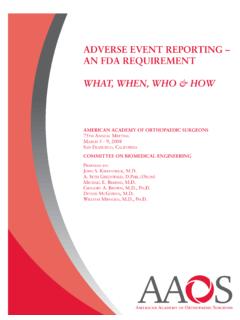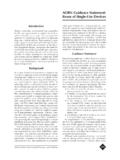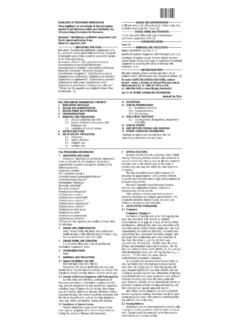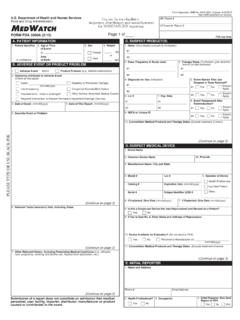Transcription of A CONTINUING EDUCATION ARTICLE MEDWATCH
1 N 1994, an A rmy medical cl i n i creported a problem during attempts toresuscitate an infant. FDA's investigationd i s c ove red that the ex p i rat o ry ch a n n e lhad become occluded after a lubricantwas used in reconnecting the endotra-cheal tube and the connector. FDA subse-quently issued a Public Health Advisory,Occluded Endotracheal Tubes(February28,1994) to manufacturers,users,andforeign governments (1).Healthcare practitioners are the pri-mary users of medical devices for directpatient such,they are in the bestposition to recognize problems (such as inthe example above) that result from theuse of medical devices. According to a1986 General Accounting Office report(2),82% of all device-related incidents arediscovered by nurses or physicians. Theoutcome of a device-related adverse eventor product problem,as with any othermedical product ( ,drug,biologic,orspecial nutritional product),can be seriousand result in illness,injury,or even death.
2 The active monitoring and reportingof medical device problems by health pro-fessionals and the facilities in which theywork leads to improved patient care andincreased safety,both for the patient andfor the operator of the device. The report-ing of device problems to the manufactur-er and/or the Food and Dru gAdministration (FDA),the federal agencywhich regulates medical devices,is a crit-ical communication link to ensure thes a fety and effe c t iveness of medicaldevices marketed in the United States. The sooner that FDA learns about aproblem,the sooner the agency can takeaction to protect patient and user a single report can initiate thisaction. Several case examples,based onactual reports received by FDA,are foundthroughout this OF A MEDICALDEVICE There probably are not many terms inthe English language that cover as muchground as medical devices.
3 Those wordsencompass a great diversity of products frombandages to heart valves,from thermometersto the most advanced therapeutic and diag-nostic machinery (3).David A. Kessler,MDFormer Commissioner ofFood and DrugsThe Fe d e ral Fo o d,D ru g,a n dCosmetic Act (4)defines a medical deviceas "an instrument,apparatus,implement,machine,c ontrivance,implant,in vitroreagent,or other similar or related arti-cle,..which for use in thediagnosis of disease or other conditions,or in the cure,mitigation,treatment,orp revention of ,or intended toaffect the structure or any function of ,and which does not achieve any ofits principal intended purposes throughchemical action within or on which is not dependent uponbeing metabolized for the achievement ofany of its principal intended purposes."Therefore,medical devices are differentfrom drugs,which work by chemical ormetabolic reactions within or on the bodyto achieve their principal intended are approximately 1800 cate-gories of medical devices,and they vary inboth complexity and risk potential.
4 Someof the more common medical dev i c e si n clude ve n t i l at o rs ,h e a rt va l ve s ,p a c e-makers,X-ray machines,infusion pumps,implants,biopsy equipment,and to devices such ashoses,tubing,or software controlling adevice are also regulated as devices. Lesscomplicated devices include sutures,bed-p a n s ,t h e rm o m e t e rs ,s h a rps containers ,and medical gloves. Examples of lesserknown products that are also regulated asdevices are laboratory diagnostic tests;sterilants and disinfectants used for med-ical devices; water treatment used for dial-ysis; cementing agents; sunglasses; topi-A CONTINUING EDUCATION ARTICLEMEDWATCHIMPROVING PATIENT CARE BYREPORTING PROBLEMS WITH MEDICAL DEVICESP rovided as a service by the Uniformed Services University of the Health Sciences, Bethesda, MD andthe Food and Drug Administration, Rockville, MDLearning Objectives:Upon completion of this program,health professionals should be able to: Describe what constitutes a medicaldevice Explain the importance of medicaldevice postmarket surveillance List the three broad types of medicaldevice adverse events Define their responsibility to reportmedical device adverse events Define the user facility s responsibilityto report to FDA and/or manufacturers Describe methods used by FDA to inform health professionals regarding medical device safetyGale G.
5 White,MS,RNDeputy Director,MEDWATCHO ffice of the Commissioner,FDAMary D. Weick-Brady,MSN,RNBranch Chief,Division of PostmarketSurveillance,Center for Devices andRadiological Health,FDAF aculty:Stephen A. Goldman,MDAssoc. Dir. for Medicine,MEDWATCHO ffice of the Commissioner,FDAT homas P. Gross,MD,MPHD irector,Division of PostmarketSurveillance,Center for Devices andRadiological Health,FDAD ianne L. Kennedy,MPH,RPhDirector,MEDWATCHO ffice of the Commissioner,FDAB renda S. Lucas,MEd,RNNurse Consultant,Division ofPostmarket Surveillance,Center forDevices and Radiological Health,FDAK atharine Merritt,PhDBiologist,Office of Science andTechnology,Center for Devices andRadiological Health,FDAC harlotte Naschinski,MS,RNDeputy Director, CONTINUING Educationfor Health ProfessionalsUniformed Services University of theHealth SciencesISeptember 1997cal wound dressings; home diag n o s t i ckits; and even leeches. Simply,if a product is not a medica-tion (drug or biologic) and is used fordiagnosis or treatment,it is probably amedical understanding of the routes bywhich medical devices come to be mar-ke t e d, and the limitations of wh at isknown about a device before it is market-ed,offers valuable insight into why it is soimportant that health professionals closelymonitor medical devices which they use intheir clinical PREMARKET REVIEWB efore medical devices can be madeavailable for use by the healthcare com-munity,the manufacturer must first gainapproval or permission for marketing byF DA.
6 Pa rt of the pre m a rket rev i ewrequires that device manufacturers devel-op good testing and manufacturing prac-tices (which are inspected by FDA). Thedesired outcome of this process is the pro-duction of a consistently well-made, reli-able,safe,and effective medical devicewhich the user can depend upon to func-tion for the specified life of the was not until 1976,when Congressamended the Food,Drug,and CosmeticAct,that FDA received the authority tore q u i re that new medical devices beproven safe and effective before beingmarketed. Prior to that time,FDA couldonly take action against hazardous or mis-represented devices after they were in themarketplace. The 1976 law created twoprimary routes to market medical devices,based on risk potential and product com-plexity:1) The 510(k) or premarket notifi-cationis the simplest and most commonroute.
7 For a device to be cleared via thisroute,the manufacturer must demonstratet h at the new product is "substantiallyequivalent" to a device that is already on the market (the assumption is that the newp roduct is safe and effe c t ive for theintended use,performs consistently,and isas good as what is currently available onthe market). FDA then reviews the deviceby assessing the similarities to a device(s)already on the market. Examples includeinfusion pumps,foley catheters,and endo-tracheal ) The PMA or premarket app-roval applicationroute must be used ifthe new medical device is not similar to adevice already on the market. In this case,the manufacturer must conduct clinicaland pre clinical scientific studies todemonstrate that the device is safe andeffective for its intended uses. Examplesof devices in which a PMA was filedinclude stentless heart valves,coated vas-cular grafts,and implantable devices thatcombine cardiac pacing with defibrilla-tion.
8 Note:Medical devices which were onthe market prior to 1976 were "grandfa-thered," which means they were allowedto remain in general use, but are subject toan FDA request for safety and effective-ness data from studies. In spite of a ri go rous pre m a rke treview process,medical devices (or anyother medical products) are only as safe asthe information known at that moment intime. For example, clinical trials for amedical device may involve only a fewhundred patients; medical devices are typ-ically "bench-tested" (rather than tested inreal-life clinical situations); and unlikedrugs,most durable medical devices haveno established end-of-life ( ,it isunknown how long a device can be usedand how fre q u e n t ly it can be used).Th e re fo re,h e a l t h c a re pro fe s s i o n a l scannot assume that FDA has deter-mined definitively that a device clearedfor marketing is ab s o l u t e ly safe fo rhuman accumulation,review,and evalu-ation of information that is gained about aproduct once it is cleared and available formarketing is calledPostmarket IMPORTANCE OFPOSTMARKET SURVEILLANCEOnce the premarket process is com-pleted and a device goes into widespreaduse,unforeseen problems can still example,adverse effects that occurrelatively rarely or relate to product label-ing (including instructions) or user tech-nique and skill,cannot always be detectedduring the premarket review.
9 Furthermore,questions related to durability,biocompat-ibility,and toxicology in humans may notbe answered with certainty until a devicehas been on the market for a number ofyears. Hospitals and other clinical settingsmonitor for problems with devices andother products within their fa c i l i t i e s .These internal surveillance systems helpto track and trend problems within thefacility to improve the delivery of and manufacturers utilize a vari-ety of postmarket surveillance tools to sig-nal important events or trends in order tohelp identify the cause of device failuresand to take appropriate action. In addi-tion,medical devices continue to be testedby the manufacturer even after also performs in-house laboratoryresearch to further analyze problems relat-ed to device optimize postmarket surve i l-lance in the detection of medical deviceproblems,FDA and manufacturers aredependent upon individual healthcareprofessionals and the facilities in whicht h ey wo rk to rep o rt pro blems withmedical devices.
10 IDENTIFYING AND AVOIDINGPROBLEMS WITH MEDICALDEVICEST ypes of ProblemsProblems with medical devices generallyfall into one of the following three broadcategories: Device Problems:D evice pro blems include malfunc-tions ( ,mechanical,electrical,or soft-wa re - re l at e d ) ,m a nu fa c t u ring defects inproduct design or development,or materi-al problems such as product instability. Use Problems:Use problems may be caused by inad-equate or misleading labeling,confusinginstructions,inadequat e packaging,design Improving Patient Care by Reporting Problems with Medical Devices2 CASE EXAMPLE:An 81 year old femalewas undergoing surgery for a left hipimplant. The surgery was proceeding rou-t i n e ly until the surgeon placed bonecement into the acetabular area in prepara-tion to fit the hip implant. The patientwent into anaphylactic shock and - Is bone cement a medical device?

